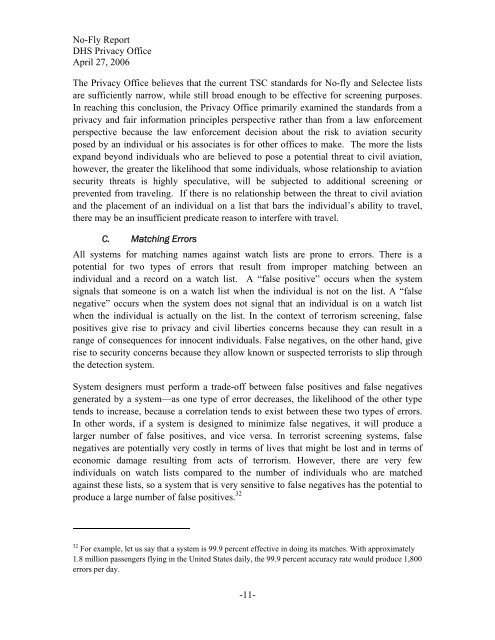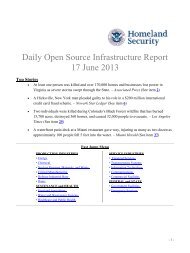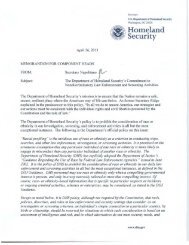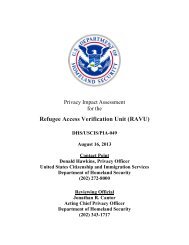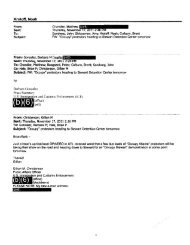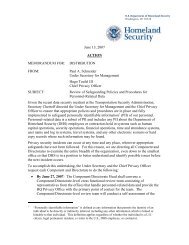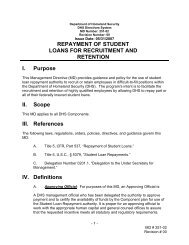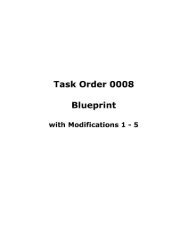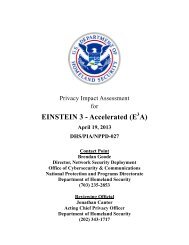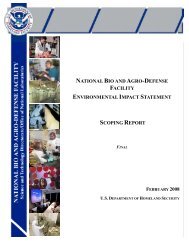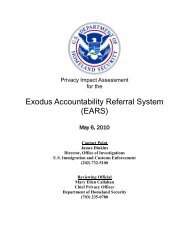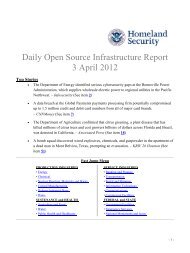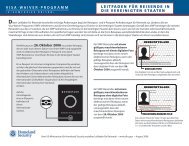Report: No Fly - Homeland Security
Report: No Fly - Homeland Security
Report: No Fly - Homeland Security
You also want an ePaper? Increase the reach of your titles
YUMPU automatically turns print PDFs into web optimized ePapers that Google loves.
<strong>No</strong>-<strong>Fly</strong> <strong>Report</strong><br />
DHS Privacy Office<br />
April 27, 2006<br />
The Privacy Office believes that the current TSC standards for <strong>No</strong>-fly and Selectee lists<br />
are sufficiently narrow, while still broad enough to be effective for screening purposes.<br />
In reaching this conclusion, the Privacy Office primarily examined the standards from a<br />
privacy and fair information principles perspective rather than from a law enforcement<br />
perspective because the law enforcement decision about the risk to aviation security<br />
posed by an individual or his associates is for other offices to make. The more the lists<br />
expand beyond individuals who are believed to pose a potential threat to civil aviation,<br />
however, the greater the likelihood that some individuals, whose relationship to aviation<br />
security threats is highly speculative, will be subjected to additional screening or<br />
prevented from traveling. If there is no relationship between the threat to civil aviation<br />
and the placement of an individual on a list that bars the individual’s ability to travel,<br />
there may be an insufficient predicate reason to interfere with travel.<br />
C. Matching Errors<br />
All systems for matching names against watch lists are prone to errors. There is a<br />
potential for two types of errors that result from improper matching between an<br />
individual and a record on a watch list. A “false positive” occurs when the system<br />
signals that someone is on a watch list when the individual is not on the list. A “false<br />
negative” occurs when the system does not signal that an individual is on a watch list<br />
when the individual is actually on the list. In the context of terrorism screening, false<br />
positives give rise to privacy and civil liberties concerns because they can result in a<br />
range of consequences for innocent individuals. False negatives, on the other hand, give<br />
rise to security concerns because they allow known or suspected terrorists to slip through<br />
the detection system.<br />
System designers must perform a trade-off between false positives and false negatives<br />
generated by a system—as one type of error decreases, the likelihood of the other type<br />
tends to increase, because a correlation tends to exist between these two types of errors.<br />
In other words, if a system is designed to minimize false negatives, it will produce a<br />
larger number of false positives, and vice versa. In terrorist screening systems, false<br />
negatives are potentially very costly in terms of lives that might be lost and in terms of<br />
economic damage resulting from acts of terrorism. However, there are very few<br />
individuals on watch lists compared to the number of individuals who are matched<br />
against these lists, so a system that is very sensitive to false negatives has the potential to<br />
produce a large number of false positives. 32<br />
32 For example, let us say that a system is 99.9 percent effective in doing its matches. With approximately<br />
1.8 million passengers flying in the United States daily, the 99.9 percent accuracy rate would produce 1,800<br />
errors per day.<br />
-11-


